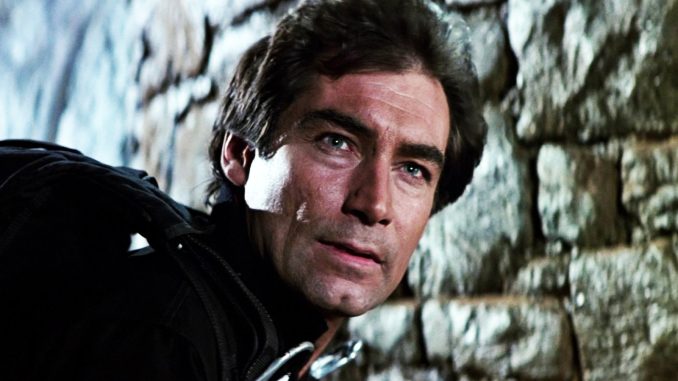
2006’s “Casino Royale” opens with a black and white sequence that depicts on-screen, for the very first time, a pre–double-O James Bond. Daniel Craig’s spy has yet to earn his license to kill, but in the film’s opening sequence, he manages to rack up the requisite kill count to finally earn the distinction.
In Prague, Bond breaks into the office of traitorous MI6 agent Dryden (Malcolm Sinclair), who immediately taunts Craig’s spy, revealing that he’s aware Bond is yet to gain his license to kill. “Your file shows no kills,” he says, “and it takes…” before Bond interrupts with, “Two.” We’re then shown a brief flashback in which Bond kills Dryden’s contact after a bathroom brawl, revealing that he’s already dispatched one of the two people he needs in order to become a double-O agent. Dryden then begins to say how easy the second kill is compared to the first, but Bond interrupts with a shot from his silenced pistol, before delivering the line, “Yes, considerably,” in what remains one of the most unequivocally badass openings to a Bond movie in franchise history (“Casino Royale” is the best Bond movie, after all).
In the space of about three minutes, then, “Casino Royale” shows us how Bond became 007, with its terse yet effective setup — though the “7” remains unexplained. But while the movie follows Ian Fleming’s original 1953 novel quite closely in places, this opening sequence isn’t quite the way things went in the book. In fact, the origin of James Bonds’ famous 007 code name remains somewhat of a mystery, both in terms of the in-universe explanation and the real-world story of how Fleming settled on those three digits. What’s more, Craig’s brief on-screen Bond flashback was almost preceded by an entirely different film that would have seen Timothy Dalton’s version of the spy getting his own origin story.
How Bond got his 007 codename in the books
James Bond first came to life in 1952, when at-the-time 43-year-old Ian Fleming sat down at his typewriter to write his first spy novel featuring the character. The former British Naval Intelligence officer soon produced “Casino Royale,” which was first published in 1953 and saw Bond travel to France to bankrupt Soviet secret service member Le Chiffre in a high-stakes baccarat game.
The very first Bond novel was also the very first time the 007 code name was used. In fact, it was the title of chapter three, “The Number 007,” in which the spy reveals that the double-O prefix means “that you’ve had to kill a chap in cold blood in the course of some assignment.” But this is where things get a little murky. The Bond of “Casino Royale” also tells his French Deuxième Bureau contact René Mathis that he carried out “two jobs” for which he was “awarded a Double O number in the Service,” suggesting that, much like in the 2006 film adaptation, he had to dispatch two people to gain his code name.
In the book, Bond also explains that his two kills came as part of two separate jobs, one in New York and the other in Stockholm, so it seems that his 007 monicker did indeed come as the result of him offing two “villains,” as he puts it in the story. One thing “Casino Royale” did not clarify, however, was that the double-O status came with the famous license to kill. Fleming would later introduce that concept in the third Bond novel, “Moonraker,” which was published in 1955. By the time the first Bond movie, “Dr. No” debuted in 1962 and kicked off cinema’s most enduring franchise, Bond’s license to kill was taken as a given, and no explanation or back story was provided in Sean Connery’s debut outing. Not until Daniel Craig took on the lead role would we see a pre-007 version of Bond. But we almost got an entire backstory for the character a lot sooner than 2006, and I’m not talking about the obscure animated series “James Bond Jr.” which rewrote 007 history.
The unmade Timothy Dalton Bond origin story
There have been several unmade James Bond movies, from Sean Connery’s never-realized 007 film featuring robot sharks to Danny Boyle’s failed Bond outing full of “crazy, mad-cap ideas.” But one of the more intriguing examples was a project overseen by longtime Bond screenwriter Richard Maibaum and producer Michael G. Wilson, which would have seen a young Bond embarking on his first mission for MI6.
Timothy Dalton debuted in 1987’s “The Living Daylights,” introducing a more rugged and grounded Bond long before Daniel Craig took a similar approach with “Casino Royale.” But it seems this could have been a very different debut for Dalton. As detailed in Bond expert Mark Edlitz’s book, “The Lost Adventures of James Bond,” (via SyFy) before “The Living Daylights” being written, the film was envisioned as a full James Bond origin story, with Maibaum and Wilson producing a treatment that detailed a hang-gliding sequence and Bond meeting Felix Leiter and Q for the first time.
The movie would have also seen Dalton’s Bond dispatched to Singapore, where he would have been overseen by a double-O agent named Bart Trevor. Together, the pair complete their mission, with Trevor taking on a mentorship role before sacrificing himself during the film’s climax to save Bond. After this, Bond is given Trevor’s code name: 007. Had this movie ever made it to production, then, it would have explained how Bond gained his code name, though how that code name came to exist in the first place would have remained a mystery.
One version of the never-realized film evidently concluded with the newly-instated 007 receiving his mission to investigate Dr. No, making this a true origin story for the version of Bond we saw in the very first movie back in 1962. According to Edlitz, while this version of the movie was never made, ideas from it were reused. In the Bart Trevor story, for example, Bond “goes to his ancestral home, meets his grandfather, and they go target practicing together” — an idea that was repurposed for 2012’s “Skyfall.”
There are dozens of stories for how Ian Fleming came up with the 007 prefix
While we have a pretty solid idea of how the literary and on-screen versions of Bond got their 007 designation, the true story of how Ian Fleming — who once had to apologize for Bond’s name — settled on those three figures remains elusive. Writing for the Literary James Bond magazine “The Real James Bond” author, Jim Wright, took a deep dive into the origins of the code name and it turns out there’s a lot to parse on that particular subject. The sheer amount of apocryphal stories that claim to contain the real source of the 007 prefix is overwhelming. Since Bond’s debut there have been stories that claim his code name comes from a hotel room number, a bus route, a Rudyard Kipling story, and more. It seems, as with any massively popular cultural figure, everybody has been eager to claim a piece of Bond history.
As Wright details, certain fans claimed Fleming chose 007 based on the international dialing code for Russia, but country codes weren’t introduced until the early 1960s, meaning Fleming couldn’t have used them as inspiration for his 1953 debut Bond novel. Others have claimed 007 is part of the ZIP Code for a section of Washington, D.C., but as Wright points out, the U.S. didn’t start using ZIP Codes until 1963. Other dodgy explanations for the 007 origins include the claim that Fleming took the number from a Rudyard Kipling short entitled “.007.” The James Bond 007 Museum in Nybro, Sweden seems to back this explanation on its website, but the only indication that Fleming used this as his inspiration is the fact that the number is the same, barring the decimal point. Otherwise, there’s been no official confirmation of this claim.
One of the more enduring stories for the origin of the 007 code name came from author Donald McCormick, whose 1968 book “John Dee, Scientist, geographer, astrologer, and secret agent to Elizabeth I” claimed that Dee signed his royal communiqués with a secret code that resembled the 007 designation. As McCormick wrote, “The two circles symbolize John Dee’s own eyes as the eyes of Queen Elizabeth. The 7 is the alchemist’s lucky number.” This explanation persisted for years as it was repeated by other authors and turned up in The Guardian and New Scientist. But as Wright notes, author Jeremy Duns dubbed McCormick a “fraud” who created so-called “facts” about Fleming’s life out of whole cloth. Indeed, rare books librarian for the Royal College of Physicians, London, Katie Birkwood told Wright, “The only problem with the John Dee story is I’ve never been able to find any evidence for it.”
So, how did Fleming come up with the 007 code name?
How Ian Fleming came up with 007
Ian Fleming created James Bond to overcome some real-life anxiety. But did the man himself ever explain where he got 007 from? Well, sort of. In a 1964 Playboy interview, shortly before the author died, he was asked about whether the double-O code was based on a real MI6 convention, and revealed that it was “purely a fictional device to make Bond’s particular job more interesting.” However, he went on to explain that “the double-O prefix is not so entirely invented as all that,” adding:
“I pinched the idea from the fact that, in the Admiralty [the military department in charge of the Royal Navy], at the beginning of the war, all top-secret signals had the double-o prefix. This was changed subsequently for the usual security reasons, but it stuck in my mind, and I borrowed it for Bond and he got stuck with it.”
As such, we can be fairly certain that the double-O section of Bond’s code name came from Fleming’s experience in the Navy. But what about the 7? According to Jim Wright, it is widely believed that the writer chose 7 simply because “it’s considered lucky” and is “popular.” As it stands, it seems we’ll never truly know why Fleming went with 7 as Bond’s code name, but in a sense, it makes it all the more intriguing and mysterious — just like the man himself.

Leave a Reply